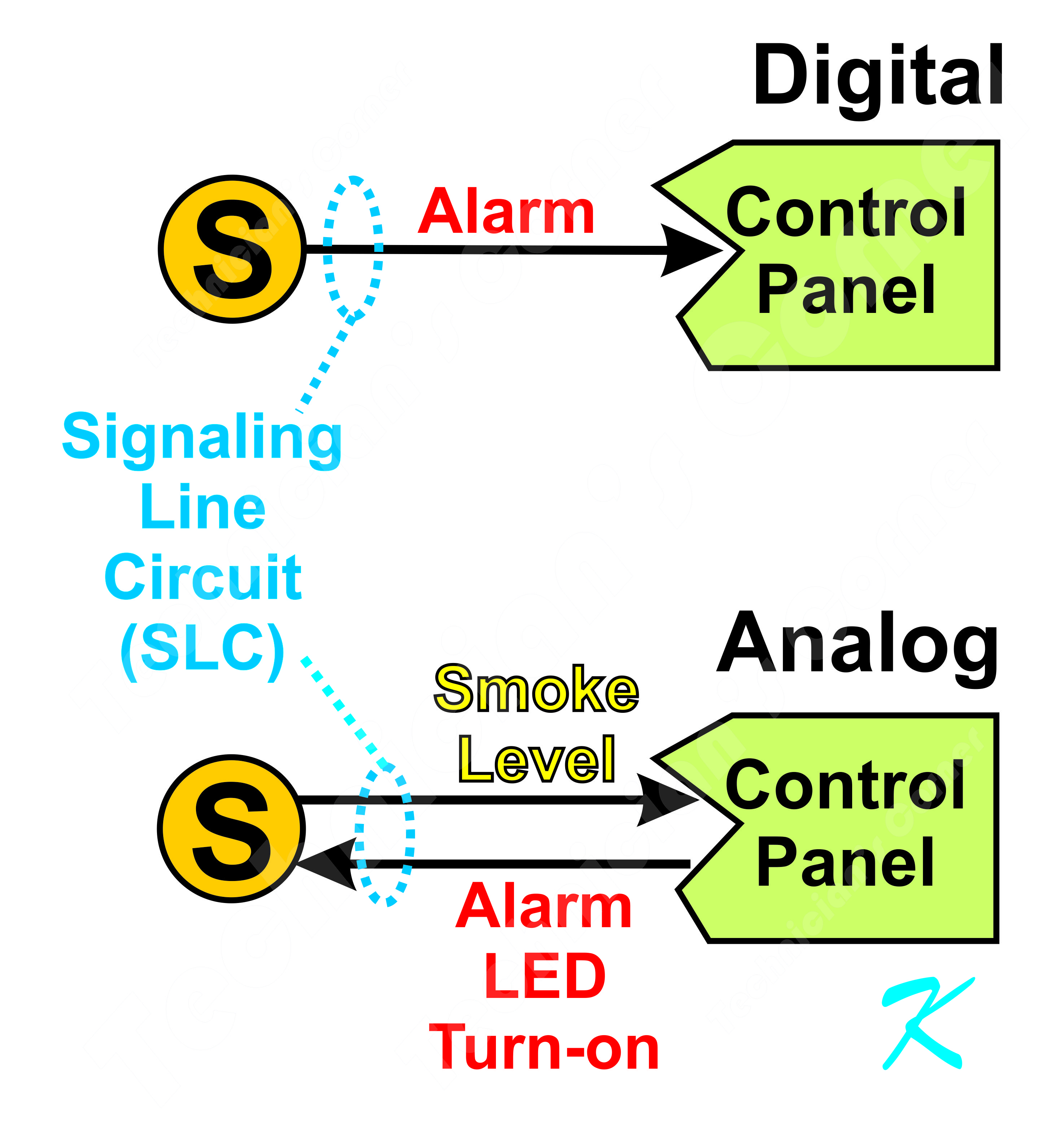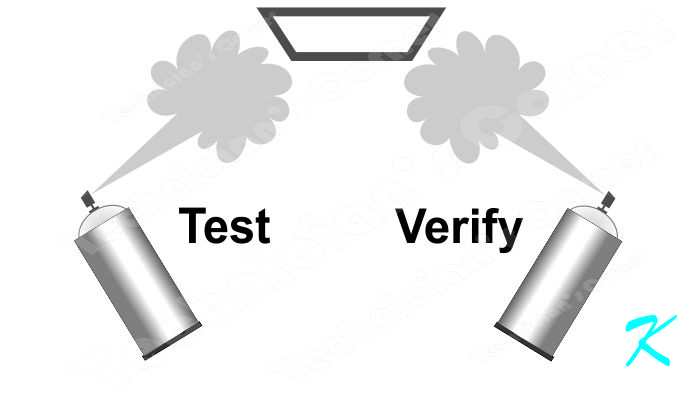Guess-and-Confirm
This is the quickest and easiest method of finding problems, the more times you have guessed-and-confirmed, the closer your guesses will be to the problems. That's called experience.
Change Tactics
You had been testing the smoke detectors, now you change from the fire alarm inspection tactic of "checking to see that signals are sent between the smoke detectors and the control panel", to the troubleshooting tactic of "analyzing the signals between the smoke detectors and control panel." The whole problem you are having isn't just one of whether signals are being sent, but one of what the fire alarm system as a whole is doing with the signals that are being sent.
In an addressable system, starting from the bottom up, there are two basic methods of communicating between the smoke detectors and the panel: the Digital System and the Analog System.

Digital
Often, with the digital system, when it senses smoke, the smoke detector is what decides that there is enough smoke to cause an alarm. When this happens, the detector turns on its own red light, and then sends a signal to the control panel that there is an alarm. In some ways, the digital smoke detector is almost acting like a conventional smoke detector.
Once it receives the alarm, the control panel then deals with the alarm as an alarm.
The system is referred to as a "Digital" system because in a digital system, the detector sends a digital "Alarm" or "Not-Alarm" signal.
Analog
On the other hand, with the analog system, when it senses smoke, the smoke detector doesn't decide if there's enough smoke to cause an alarm. All it does is to send information telling the control panel how much smoke it has detected. This information is sent every five seconds or so as the control panel is polling the detector to ask the detector if it's still connected to the system. The control panel then takes this information and the panel itself makes the decision of whether there's enough smoke to make an alarm or not.
When the panel decides that there is enough smoke, then, and only then, the control panel sends a signal back to the smoke detector to turn on the detector's red light. At this time, the panel also sounds the alarm.
This system is referred to as an "Analog" system because the detector is sending a smoke level signal; the detector is sending a varying length electrical pulse to the panel to indicate how much smoke is present. The pulse is quick (short duration) to say "not much smoke" or maybe slower (longer duration) to say "more smoke". The panel, then, is using the length of this pulse for making its alarm decision.
Verification
Verification is skepticism: the smoke detector senses smoke, but the fire alarm system doesn't really believe that it's smoke until it has had a chance to verify.
If the detector decides about alarms, the detector does its own exact method of verification. During the verification period, its red light might be turned on, but until the detector decides that there really is smoke, the detector doesn't send an alarm to the control panel.
If the control panel decides about alarms, the smoke detector isn't sending an alarm signal at any time; the smoke detector is only sending a signal to tell the panel how much smoke is present in the detection chamber.
Normally, during the slow-check period, the panel is receiving the smoke level information every five seconds (the detector's light blinks every five seconds as it is being polled). If the detector senses smoke, the panel receives the increased smoke level information and goes into fast-checking the detector (the detector's light blinks every one or two seconds).
Once the panel decides that the smoke isn't just going away, the panel goes into full alarm mode.
Issues with Non-Alarms
From your description, it looks like this is an analog addressable fire alarm system; the detectors don't call the alarm, the panel calls the alarm.
Verification Troubles
This problem is the quickest to test for.
If the issues you're facing are caused by verification, what is happening with the detectors is that you are not getting full verification. This isn't really a problem; this just looks like a problem.
To start with, before spraying in your smoke, the panel is slow-checking all the detectors and modules in the system. During the slow-checking, when the smoke detector tells the panel about the smoke you've sprayed into the detector's sensing chamber, the panel switches to a fast-check of that detector. The panel, at this time, also turns on it's own alarm light, but doesn't take the action of sounding the alarm to the whole building because it is skeptical that this is really an alarm.
During the next minute or so, the smoke inside its sensing chamber is dissipating rapidly. Each time during the fast-check, the panel is asking the smoke detector how much smoke is there, and each time, the smoke detector is telling the panel that there is quite a bit less smoke. When the smoke levels get down to an acceptable level, the panel considers that there really wasn't smoke caused by a fire, turns off its own alarm light, and goes back to the slow-check polling of that detector.
There are other causes of the system not working, but this one is easy to check. First off, is there a lot of air movement around those detectors? If so, after first spraying smoke, wait about 30 seconds and spray again. That will cause the detector to send a signal that the smoke levels are still high, and the panel will at that time sound the alarm.
Even if the air isn't moving very much during the testing, use the double-spray method to test verified smoke detectors. That saves time in the long run.
Real Problems
If its real problems you're finding, and not just the perceived timing problems discussed above, the system can be divided into three areas.
- Smoke Detector
- Communication Lines (in this case the wires of the Signaling Line Circuit or SLC)
- Control Panel
Smoke Detector
The smoke detectors could be having troubles detecting smoke, or sending its alarm or smoke level information. The smoke detectors could also be addressed wrong and two detectors are sending their signals at the same time. If it's not a verification timing problem, this is at least worth checking out.
Communication Lines
The signals traveling along the communication wires (Signaling Line Circuit or SLC) can be distorted by affects that have been injected into the system.
Some of the troubles can be caused by stray capacitance or inductance on the line. Both of these can affect the wave-shape of the pulses, which affect the pulse lengths received by the panel. In this case, the smoke detector might send a specific pulse length signal, but the Signaling Line Circuit (SLC) could be changing the shape of the pulse, so the panel sees a different length pulse with than the detector is sending.
Another possibility is that a detector, module, or even the panel could be dragging down the total voltage on the SLC, and then the panel perceives a different pulse length than the detector is sending.
Using a voltmeter to identify these problems is difficult, but not impossible. Whereas these problems can be identified easily using an oscilloscope, a standard voltmeter can sort of identify that problems exist. In order to identify any of these problems with a voltmeter, however, one has to be very familiar with the voltmeter, its sampling rate, its sampling width, and exactly what method it uses to provide a displaying number: is it RMS reading, Averaging, Etc. It also helps to compare the signals on the problem system to signals on a good system.
I've even seen where problems like this are caused by "soft" wire to wire shorts with water on the circuit. See:
How Does One Find a Soft Ground Fault?
Control Panel
The panel could be using too high or too low of voltage on the SLC. I had to replace a loop controller card in a fire alarm system because it's voltage was too high and it wasn't always correctly communicating with the modules connected to the SLC.
Control Panel Programming
Then there could be problems with the programming.
- Verification - set wrong
- Device Type - set to supervisory and not alarm
- Non-Latching - when the detector should be set to latching
- Internal Signal Routing - sometimes called mapping, rules, or some other name. This determines what the outputs are going to do when an alarm is detected on a smoke detector. Each smoke detector can be programmed differently
You will have to look at the program on your laptop computer to verify that the inputs are all programmed correctly.
There are a lot of possibilities, and you have to be open to all of them. It's only after eliminating the possibilities, one at a time, that you can really trim them all down to find the cause of the problem.
Douglas Krantz

